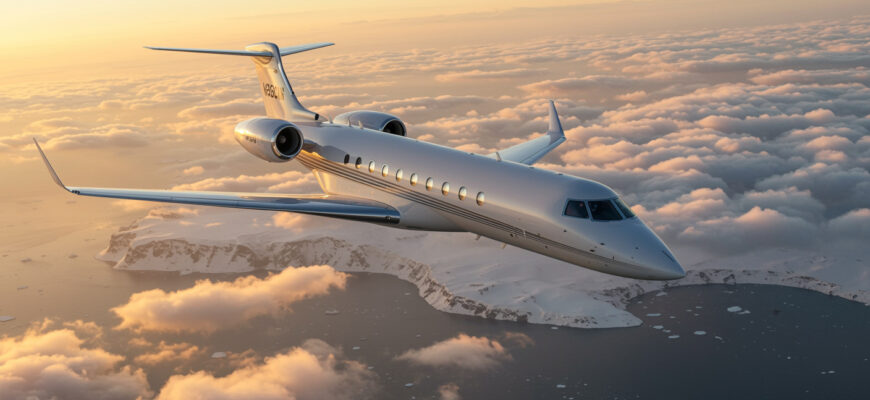Traveling to Antarctica by private jet is no ordinary journey—it’s an expedition to one of the most remote, pristine, and challenging corners of the planet. While commercial flights don’t serve this icy continent, private jet charters open up a world of exclusive access, unmatched comfort, and a chance to experience a destination few have stepped foot on. But behind the glamour of soaring over endless ice caps and untouched wilderness lies a complex web of logistics, regulations, and operational hurdles that set Antarctic jet charters apart from any other trip.
Understanding Private Jet Charter Flights to Antarctica
Private jet travel to Antarctica combines adventure and luxury but demands careful preparation and specialized knowledge.
Overview of Private Jet Travel to Antarctica
Unlike typical private jet charters, flights to Antarctica operate under unique conditions. The continent has no commercial airports — all arrivals rely on specially maintained blue-ice runways or snow-covered airstrips that require aircraft capable of handling icy surfaces and extreme cold. Trips often depart from southern cities like Cape Town, South Africa, or Punta Arenas, Chile, and take about 4.5 to 5 hours for the segment to Antarctica’s landing zones.
Flights are primarily seasonal, running during the Antarctic summer months (November through January) when daylight is continuous and weather conditions are most stable. Most private jet charters to Antarctica are short “flightseeing” visits, often lasting only a few hours on the ground, though multi-day expeditions with stay-over camps do exist but require even more complicated logistics.
Why Choose Private Jet Charter for Antarctica Travel: Ultra-Luxury, Adventure, and Corporate Benefits
The draw of flying private to Antarctica is powerful. Here’s what sets private jet charters apart:
- Ultimate Privacy and Comfort: Travelers avoid crowded cruises or commercial charters, enjoying spacious cabins, personalized service, and complete control over schedules.
- Speed and Efficiency: Private jets drastically cut travel times to and from departure points, shaving off hours or days compared to ship-based tours.
- Flexible Itineraries: Charter flights enable tailored routes and timing, whether it’s a quick day trip or a more involved scientific or corporate mission.
- Corporate and VIP Appeal: Exclusive corporate retreats, scientific teams, and high-net-worth individuals leverage private jets for discreet, efficient access.
- Adventure and Uniqueness: Combining luxury with thrill, these flights offer a bucket-list experience few can claim, making them ideal for adventure seekers who want the best of both worlds.
Key Challenges and Considerations: Extreme Weather, Limited Infrastructure, and Regulatory Hurdles
Despite the allure, several obstacles make Antarctic private jet charters complex:
| Challenge | Description | Impact |
|---|---|---|
| Extreme Weather | Antarctica’s climate is notoriously unpredictable, with sudden storms, strong winds, and temperatures plunging well below freezing even in summer. | Flights are frequently delayed or rerouted; constant weather monitoring and backup plans are essential. |
| Limited Infrastructure | Runways are composed of ice or snow with no traditional refueling or maintenance facilities available on site. | Aircraft must carry enough fuel for round trips and require specialized polar-rated maintenance and pilot expertise. |
| Regulatory Hurdles | Landing in Antarctica involves navigating strict international treaties like the Antarctic Treaty System, plus coordination with national Antarctic programs for permits. | Operators must secure multiple approvals months in advance, ensuring environmental protection and adherence to protocol. |
These factors create a delicate balance for operators and travelers alike. Achieving a seamless Antarctic jet charter means teaming up with experienced providers who understand every twist and turn of the regulatory and environmental landscape. It’s not just about owning a jet; it’s about mastering one of the toughest refueling stops on Earth.
Whether the goal is a quick private jet day trip to set foot on the White Continent or a multi-day expedition to its depths, understanding these fundamentals is the first step toward preparing for an authentic polar experience wrapped in luxury and exclusivity.
Logistical Challenges of Flying Private Jets to Antarctica
Flying a private jet to Antarctica puts any pilot and operator through their paces. The continent’s extreme conditions and isolated location turn a routine flight into a complex mission. How do operators decide when it’s safe to fly, manage landings on ice runways, and keep everything running smoothly miles from civilization? The answers lie in meticulous planning and adapting to unpredictable challenges.
Weather Constraints and Seasonal Windows: Best Timing for Private Flights
Antarctica’s weather is notoriously harsh and changeable, which directly affects flight plans.
- Limited Flying Season: Flights are generally restricted to the austral summer months—November through January—when 24-hour daylight and milder conditions prevail.
- Constant Weather Monitoring: Sudden storms or high winds can ground flights for days. Operators depend on up-to-the-minute satellite data and polar weather forecasts to pick exact windows.
- Flexibility is Key: Flight schedules are often tentative, with backup days factored in to accommodate delays without disrupting passenger plans too much.
The right timing means balancing safety with opportunity—knowing when a rare clear weather day might appear during the short summer season.
Navigating Antarctica’s Remote Ice Runways and Limited Ground Infrastructure
Landing in Antarctica means touching down on blue-ice runways, which are literally frozen glacier surfaces painstakingly maintained for aircraft use.
Unlike regular airports, these runways lack paved taxiways, modern terminals, or refueling stations. Planes taxi on snow-packed surfaces, and ground support is minimal.
Every approach demands precision: pilots specially trained in polar operations must carefully judge ice conditions, runway integrity, and braking distances. Because there are no hangars or repair shops on-site, every aspect of the landing and turnaround is a logistical ballet choreographed in advance.
Fueling, Maintenance, and Crew Support Logistics in Extreme Environments
With zero fueling stations on the continent, private jets carry enough fuel for a round trip non-stop. This limits passenger capacity and cargo but is critical to safety.
Crew support is another headache. Teams need to be fully briefed on Antarctic protocols, personal equipment, and emergency systems. Meanwhile, any maintenance or repairs often require flying parts or technicians in from distant hubs like Cape Town or Punta Arenas.
All equipment must be rugged and self-sufficient to handle subzero temperatures and harsh winds. No spare fuel tanks, no mobile repair trucks—logistics here are about pre-planning every inch of operation.
Safety Protocols and Emergency Contingency Planning for Remote Operations
Safety in Antarctica isn’t optional; it’s mission critical. Operators enforce strict protocols:
- Polar-rated pilots and crew vetted for experience with ice landings and extreme cold.
- Detailed emergency evacuation plans, often including backup aircraft on standby in departure cities.
- Communication setups that function despite magnetic interference and lack of infrastructure.
- Emergency supplies and survival kits carried onboard in case of unexpected delays on the ice.
Every flight has a comprehensive contingency plan because in the remote frozen south, rescue is neither quick nor simple.
Pricing Breakdown and Cost Factors for Antarctic Private Jet Charters
Chartering a private jet to Antarctica isn’t like booking a weekend getaway. Prices reflect the heavy lifting behind making such a trip possible.
Typical Pricing Models: Hourly Rates, Charter Packages, and Additional Fees
Most operators offer various pricing schemes. Hourly rates range widely depending on the jet model, but expect $10,000+ per flight hour due to extreme operational demands.
Many clients opt for all-inclusive charter packages, such as the “Greatest Day” from Cape Town, priced around $175,000 for 12 passengers—covering flights, guided excursions, and meals.
Additional fees include:
- Permit processing and landing fees
- Ground support and logistics coordination
- Specialized insurance and safety management
Factors Impacting Pricing: Aircraft Type, Flight Duration, Landing Fees, and Support Costs
Pricing shifts drastically depending on what jet you fly. Long-range jets like the Gulfstream G650ER or Bombardier Global 7500 command premiums due to superior range and onboard comfort.
Flight distance plays a huge role—longer routes from South America or Africa increase both fuel burn and crew hours.
Landing on Antarctic ice runways incurs unique fees for runway maintenance and specialized handling.
Ground support involves experienced teams who facilitate passenger transfers, catering, and equipment handling in the field—adding to the tab.
Comparing Charter Costs with Other Modes of Antarctic Travel
Commercial expeditions by cruise ships or scheduled flights are more affordable—running from a few thousand to tens of thousands per passenger—but lack speed, flexibility, and privacy.
Private jet charters bypass weeks at sea and offer direct access, but at a cost several times higher. For those who want unmatched luxury and efficiency, the price tag often feels justified.
Tips for Budgeting and Cost Optimization without Compromising Luxury
- Book Early: Securing charters 6–12 months ahead can help lock in better rates and availability.
- Choose Smaller Groups: Flying with fewer passengers reduces fuel weight and expense.
- Leverage Broker Expertise: Established brokers often negotiate better deals and handle permits efficiently.
- Consider Shared Charters: Joining a group can spread costs without sacrificing the private jet experience.
Smart planning helps keep the journey extraordinary yet financially sensible.
Insider Route Planning and Ground Support Tips
Flying to Antarctica demands more than just picking the shortest path. Routes and ground support require expert coordination for a smooth journey.
Common Routes and Departure Points for Flights to Antarctica
The most popular gateways are Cape Town, South Africa, for interior Antarctic flights, and Punta Arenas, Chile, for Peninsula destinations.
These hubs offer direct 4.5–5 hour flight windows across the Drake Passage and have logistics companies familiar with Antarctic regulations.
Optimal Route Planning to Maximize Efficiency and Minimize Risks
Operators analyze weather models, air traffic corridors, and runway availability before finalizing routes. The goal is to minimize time over open water and avoid turbulent weather patterns.
Popular strategies include:
- Flying during midday Antarctic summer light for better visibility.
- Choosing direct paths when weather is stable, or routing around storm systems when necessary.
- Including technical stops strategically for crew rest and aircraft checks.
Coordinating Ground Support: Handling Transfers, Catering, and Passenger Comfort
Ground teams manage everything from transfers between aircraft and terminals, to catering with fresh, high-quality meals suitable for cold weather and long waits.
Passenger comfort extends to warm waiting areas, briefing sessions on safety and protocols, and personal gear handling. The limited facilities mean every detail must be prearranged.
Preparing for Delays and Weather Disruptions: Contingency Strategies
Antarctic weather delays are a given. Best operators offer layered contingency plans:
- Backup hotels or camps near departure hubs.
- Alternate flight days and rebooking options.
- Clear communication channels to keep passengers updated in real time.
Knowing these contingencies are in place allows travelers to relax and enjoy one of the world’s most exclusive adventures.









